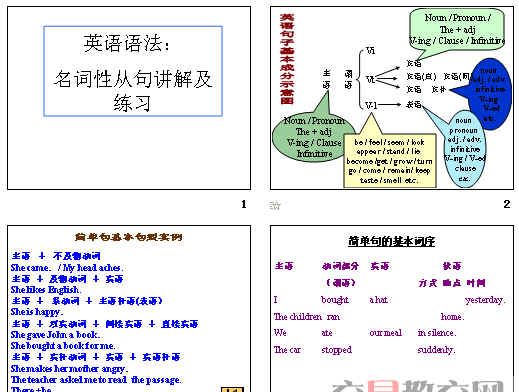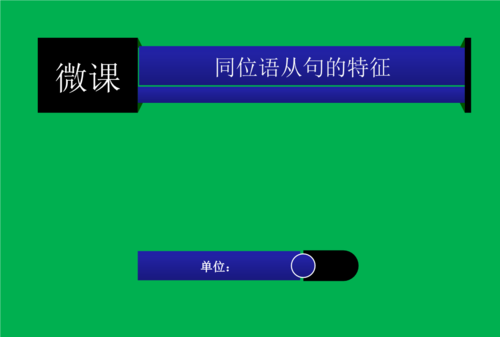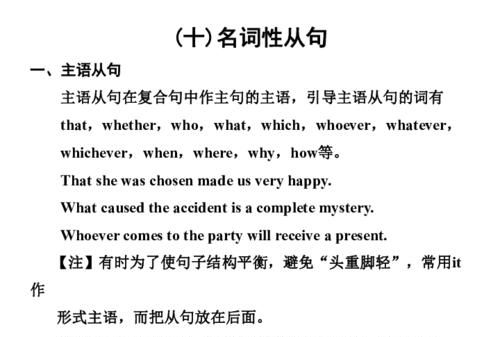本文目录
什么叫同位语从句
同位语从句
在复合句中充当同位语的名词性从句称为同位语从句。一个名词(或其它形式)对另一个名词或代词进行补充说明,这个名词(或其它形式)就是同位语。
1.用法
同位语从句一般跟在某些名词后面,用以说明该名词表示的具体内容。
I heard the news that our team had won.我听到了我们队获胜的消息。
①可以跟同位语从句的抽象名词通常有news,idea,fact,promise,question,doubt,thought,hope,message,suggestion,word(消息),possibility等。
I’ve come from Mr. Wang with a message that he won’t be able to see you this afternoon.
我从王先生那里来,他让我告诉你他今天下午不能来看你了。
②在某些名词表“建议,命令,要求等”(如demand, wish, suggestion, resolution等)后面的同位语从句要用虚拟语气 (即should+动词原形;should可省)。
There was a suggestion that Brown should be dropped from the team.
有一项建议是布朗应该离队。
③同位语从句前名词的数:同位语从句前的名词通常用单数形式,并且往往带有限定词(word除外)加以修饰。
Where did you get the idea that I could not come?你在哪儿听说我不能来?
2.连词
英语中引导同位语从句的词通有that,whether,连接代词what,who,连接副词how, when, where等。(注:if, which 不能引导同位语从句。)
(1)连词that引导同位语从句(注:引导同位语从句的that不能省略)
The idea that you can do this work well without thinking is quite wrong.
你认为不动脑筋就能做好这件工作的想法是完全错误的。(作idea的同位语)
【注意】引导同位语从句的连词that通常不省略。
(2)连词whether引导同位语从句(注:if不能引导同位语从句)
The question whether we should call in a specialist was answered by the family doctor.
我们是否请专家由家庭医生来定。
He must answer the question whether he agrees to it or not.
他必须回答他是否同意这样一个问题。
(3)其它引导词引导的同位语从句
A.连接代词
what, who, whom, whose引导同位语从句
I have no idea what size shoes she wears.我不知道她穿几号的鞋。(what作定语)
The question who will take his place is still not clear.(who作主语)
B.连接副词
when, where, how, why 引导同位语从句
We haven’t yet settled the question where we are going to spend our summer vacation.
到哪儿去度暑假,这个问题我们还没有决定。
l have no idea when he will be back.我不知道他什么时候回来。
My question how I shall get in touch with him has not been answered.
3.分隔式同位语从句
有时同位语从句可以不紧跟在说明的名词后面,而被别的词隔开。在语法上叫做分隔式同位语从句。
The thought came to him that maybe the enemy had fled the city.
他突然想起可能敌人已经逃出城了。
Several years later,word came that Napoleon himself was coming to inspect them. 几年以后,有消息传来说拿破仑要亲自视察他们。
4.定语从句与同位语从句
同位语从句是用于说明所修饰名词的具体内容的,它与被修饰词语通常可以划等号;而定语从句是限制所修饰名词的,它的作用是将所修饰的名词与其他类似的东西区别开来。
同位语从句中的引导词that不做成分,而定语从句中的引导词that做成分。
定语从句中,关系代词做宾语可以省略;同位语从句的引导词不可以省略。
We are glad at the news that he will come. 听到他要来这个消息我们很高兴。
We are glad at the news that he told us. 听到他告诉我们的这个消息我们很高兴。更多知识点可关注下北京新东方的高中听说读写拔高住宿班课程。

同位语从句是什么
基本信息
在复合句中充当同位语的名词性从句称为同位语从句。 同位语从句是名词性从句(主语从句、表语从句、宾语从句、同位语从句)中的主要从句之一,从句作同位语表示与之同位的名词(短语)的实际内容,它的作用相当于名词,对前面的名词(短语)加以补充说明或进一步解释,相当于一个表语从句,它们之间的关系是同位关系,即主表关系。
编辑本段详细信息
一个名词(或其它形式)对另一个名词或代词进行修饰,限定或说明,这个名词(或其它形式)就是同位语。同位语与被它限定的词的格要一致,并常常紧挨在一起。 同位语从句
1. 名词作同位语
Mr Wang, my child’s teacher, will be visiting us on Tuesday.王先生,我孩子的老师,星期二要来看我们。
2.短语作同位语
I, the oldest girl in the family, always had to care for the other children.我,作为家里最大的女孩,老得照料家中的其他孩子。
3. 直接引语作同位语
But now the question comes to their minds, “Did she die young because she was a clone?”但是现在他们不得不思考这样的问题:“多莉早死是因为它是一只克隆羊吗?”
4. 句子作同位语
The girls were surprised at the fact that ocean ships can sail up the Great lakes.巨大的海轮可以开到五大湖,让表姐妹俩感到吃惊。
编辑本段同位语从句用法
同位语部分是个句子,就是同位语从句,这种用法比较"固定" 一、在复合句中用作同位语的从句叫同位语从句。它一般跟在某些名词后面,用以说明该名词表示的具体内容。 I heard the news that our team had won.我听到了我们队获胜的消息。 同位语从句
二、可以跟同位语从句的名词通常有news,idea,fact,promise,question,doubt,thought,hope,message,suggestion,words(消息),possibility等。 I’ve come from Mr wang with a message that he won’t be able to see you this afternoon. 我从王先生那里来,他让我告诉你他今天下午不能来看你了。 三、英语中引导同位语从句的词通有连词 that,whether,连接副词 how,when,where等。(注:if,which 不能引导同位语从句。) He must answer the question whether he agrees to it or not. 他必须回答他是否同意这样一个问题。 四、有时同位语从句可以不紧跟在说明的名词后面,而被别的词隔开。 The thought came to him that maybe the enemy had fled the city. 他突然想起可能敌人已经逃出城了。
编辑本段同位语从句-引导词
同位语从句的引导词,引导同位语从句的词语通常有连词that,whether,连接代词和连接副词等。
1. 连词that引导同位语从句
(注:引导同位语从句的that不能省略) The idea that you can do this work well without thinking is quite wrong.你认为不动脑筋就能做好这件工作 同位语从句
的想法是完全错误的。(作idea的同位语) 【注意1】在某些名词(如demand, wish, suggestion, resolution等)后面的同位语从句要用虚拟语气 There was a suggestion that Brown should be dropped from the team. 有一项建议是布朗应该离队。 【注意2】引导同位语从句的连词that通常不省略,但在非正式文体中也可以省去。 He gabbed his suitcase and gave the impression he was boarding the Tokyo plane. 他拿起了手提箱,给人的印象是他要登上飞往东京的飞机了。
2. 连词whether引导同位语从句
(注:if不能引导同位语从句) The question whether we should call in a specialist was answered by the family doctor. 我们是否请专家由家庭医生来定。 【注意】whether 可引导同位语从句,但if不能引导同位语从句。
其它引导词引导的同位语从句
连接代词what, who, whom, whose, which引导同位语从句 1).I have no idea what size shoes she wears.我不知道她穿几号的鞋。(what作定语) 同位语从句
2).I have no idea which wine is best—it’s a matter of personal taste.我不知道哪种酒最好,这是个人口味的问题。(which作定语) 3).The question who will take his place is still not clear. (who作主语)
4. 连接副词引导同位语从句
连接副词when, where, how, why We haven’t yet settled the question where we are going to spend our summer vacation.到哪儿去度暑假,这个问题我们还没有决定。
编辑本段同位语从句-相关语法
一、同位语从句在句中的位置
1.一般情况下同位语从句跟在某些名词(如news,idea,fact,promise,hope,message等)的后面,用以说明该名词所表达的具体内容。 I’ve come from Mr Wang with a message that he won’t be able to see you this afternoon.我从王先生那边得知一个消息,他说他今天下午不能来看你了。 2.有时同位语从句可以不紧跟在它所说明的名词后,而被别的词语隔开,在语法上叫做分隔式同位语从句。 同位语从句
The thought came to her that maybe she had left the door open when she left home.她突然想起可能在她离开家时没把门关上。
二、同位语从句前名词的数
同位语从句前的名词通常用单数形式,并且往往带有限定词(word除外)加以修饰。 Where did you get the idea that I could not come?你在哪儿听说我不能来?
三、同位语从句的语气
在suggestion,advice,request,order等意为“建议;命令;要求”的名词后,同位语从句中的谓语动词通常用“should +动词原形”的虚拟语气结构,句中的should可以省略。 Our teacher gave us some advice how we(should)use the computer.老师给我们提出了一些如何使用电脑的建议。
四、同位语从句的先行词
同位语从句的先行词通常是抽象名词,常见的有:idea, situation thought, fact, evidence, belief, doubt, fear, hope, question, theory, news, order, ability等等。 How did the cheats explain the fact that the Emperor didn't feel the new clothes in him? 皇帝觉得身上并没有穿上新衣,对这个问题骗子是怎样解释的? 代词it可用作同位语从句的先行词。这个it常放在某些动词或短语动词后作宾语,同时兼作其后that同位语从句的先行词。 I owe it to you that I am still alive. 幸亏你,我现在还活着。 有的语法学家把先行词it后的that从句看作是动词或介词的真正宾语。一般认为,这种it后的that 从句应看作it的同位语,因为它相当于“主语+be+表语”结构。 You must se to it that the children don't catch cold.(=You must see to it, and It is that the children don't catch cold.)你要当心,别让孩子们着凉了。
编辑本段同位语从句-语法区别
与定语从句的的语法区别:
1.意义的不同
同位语从句是用于说明所修饰名词的具体内容的,它与被修饰词语通常可以划等号;而定语从句是限制所修饰名词的,它的作用是将所修饰的名词与其他类似的东西区别开来: We are glad at the news that he will come. 听到他要来这个消息我们很高兴。(news的内容就是that he will come,故that引导的是同位语从句) We are glad at the news that he told us. 听到他告诉我们的这个消息我们很高兴。(that从句是限制the news的内容的,即我们高兴只是因为他告诉的这个news而不是其他的news,故that从句为定语从句)
2. 引导词的不同
what, how, if, whatever 等可引导名词性从句,但不引导定语从句。
3. 引导词的功能上的不同
that引导同位语从句时,它不充当句子成分,而引导定语从句时,它作为关系代词,要么充当定语从句的主语,要么充当定语从句的宾语。如上例 that he told us中的that就充当told的宾语。
4. 被修饰词语的区别
同位语从句所修饰的名词比较有限,通常有hope, wish, idea, news, fact, promise, opinion, suggestion, truth等,而定语从句所修饰的名词则非常广泛。 另外,when和where 引导定语从句时,通常只修饰表示时间和地点的名词,而它们引导同位语从句时却不一定;又如why引导定语从句,它通常只修饰名词the reason,而它引导同位语从句时则不一定: I have no idea when they will come . 我不知道他们什么时候来。(同位语从句) I’ll never forget the days when I lived there.. 我永远不会忘记我住在那儿的日子。(定语从句)
编辑本段同位语从句-特殊形式
1.间隔同位语从句 同位语从句通常是跟在它解释或说明的名词后,但有些情况下,由于句子结构的原因,同位语从句不紧跟在名词后,而被其他的词隔开。 A warm thought suddenly came to me that I might use the pocket money to buy some flowers for my mother's birthday 简析:由于that从句太长,为避免句子失去平衡,此处用了间隔同位语从句 2.suggestion,request和order等名词后的同位语从句用虚拟语气。 She made a request that the doctor(should)be sent for at once.她请求立即请医生来。 简析:suggestion,order,request,proposal,requirement,command,advice,proposition和recommendation等名词后接同位语从句时,从句中的谓语动词要用“(should+)动词原形”的形式,其中should一词可省略。 3.短语及固定句式后的同位语从句 I will come on condition that John is invited.如果约翰也被邀请的话,我就来。 简析:短语On condition, on supposition, on the ground(s), on the understanding, with the exception, in spite of the fact, on the assumption及句式There BE+no doubt(hope,chance,possibility,…)后的that从句为同位语从句。
编辑本段同位语从句-雅思例句
1 I have a dream that one day, all roads will be made plain. 2 We hold this truth to be self-evident that all men are created equal. 3 Some people hold the opinion that the Internet is a curse. 4 Museums play a role of education for the simple reason that they provide people with a good opportunityto have a deeper understanding of their own country's tradition and cultures.

同位语从句的相关语法点(大学)
1.一般情况下同位语从句跟在某些名词(如news,idea,fact,promise,hope,message等)的后面,用以说明该名词所表达的具体内容。
I’ve come from Mr Wang with a message that he can't visit you this afternoon.我从王先生那边得知一个消息,他说他今天下午可能不能来看你了。
2.有时同位语从句可以不紧跟在它所说明的名词后,而被别的词语隔开,在语法上叫做分隔式同位语从句。The thought came to her that maybe she had left the door open when she left home.她突然想起可能在她离开家时没把门关上。 同位语从句前的名词通常用单数形式,并且往往带有限定词(word除外)加以修饰。
Where did you get the idea that I could not come?你在哪儿听说我不能来? 在suggestion,advice,request,order等意为“建议;命令;要求”的名词后,同位语从句中的谓语动词通常用“should +动词原形”的虚拟语气结构,句中的should可以省略。
Our teacher gave us some advice how we(should)use the computer.老师给我们提出了一些如何使用电脑的建议。 同位语从句的先行词通常是抽象名词,常见的有:idea,situation thought,fact,evidence,belief,doubt,fear,hope,question,theory,news,order,ability等等。
How did the cheats explain the fact that the Emperor didn't feel the new clothes in him? 皇帝觉得身上并没有穿上新衣,对这个问题骗子是怎样解释的?
代词it可用作同位语从句的先行词。这个it常放在某些动词或短语动词后作宾语,同时兼作其后that同位语从句的先行词。
I owe it to you that I am still alive. 幸亏你,我此刻还活着。
有的语法学家把先行词it后的that从句看作是动词或介词的真正宾语。一般认为,这种it后的that 从句应看作it的同位语,因为它相当于“主语+be+表语”结构。
You must see to it that the children don't catch cold.(=You must see to it,and It is that the children don't catch cold.)你要当心,别让孩子们着凉了。

引导同位语从句的抽象名词有哪些
age,beauty,childhood,capacity,work。同话,欢迎来交流

以上就是关于同位语从句中的抽象名词有几种 ,什么叫同位语从句的全部内容,以及同位语从句中的抽象名词有几种 的相关内容,希望能够帮到您。

